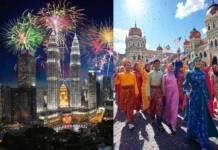Nagaland State Foundation Day is celebrated every year on December 1st to mark the day when Nagaland became the 16th state of India in 1963. This day is very important because it remembers the long struggle of the people of Nagaland to get their own state.
Before Nagaland became a state, the people fought for their rights and worked hard to make their dreams come true. Their efforts led to the creation of Nagaland as a separate state in India, where many different tribes and communities live together.
The Foundation Day is a time to remember the state’s history, celebrate its rich culture, and look forward to a bright future. Nagaland is known for its beautiful landscapes, traditions, and diversity, which contribute to the culture of India.
On this day, people honor the past and think about how the state can continue to grow and develop. It’s a day of pride and unity for everyone in Nagaland.
Key Details
| Attribute | Details |
|---|---|
| State Name | Nagaland |
| Foundation Day Date | December 1st (Annually) |
| Year of Formation | 1963 |
| Formed From | Assam (Nagaland was part of Assam before its formation) |
| Capital City | Kohima |
| First Chief Minister | P. Shilu Ao |
| Significance | Marks the formation of Nagaland as the 16th state of India |
History of Nagaland Foundation Day
The history of Nagaland’s Foundation Day is closely linked to the long struggle of the Naga people for their own state. Before December 1, 1963, Nagaland was part of the larger state of Assam. The people of Nagaland, with their unique culture and identity, felt that they were different from the Assamese people and wanted to have their own state.
The demand for a separate state started in the early 1900s, but it became stronger after India gained independence in 1947. The Naga National Council (NNC), led by important Naga leaders, fought for this cause. They wanted more control over their land and future.
The Indian government and Naga leaders held many talks over the years, and in 1960, the Naga People’s Convention played a key role in pushing for the creation of Nagaland as a state. Finally, on December 1, 1963, Nagaland became the 16th state of India with Kohima as its capital.
This day is special because it marks the Naga people’s successful fight for their rights, and it also celebrates their unique culture and identity. It is a day to remember how the state was formed and how important it is for India to respect the diversity of all its regions.
Cultural and Economic Contributions
Nagaland is one of India’s most culturally rich states, renowned for its ethnic diversity, unique festivals, and vibrant traditional arts. The state is home to 16 major tribes, each with its own distinct customs, language, and attire. The Hornbill Festival, celebrated annually, is the most prominent cultural event, showcasing the traditions, dance, music, and food of Nagaland’s various tribes.
Economically, Nagaland is known for its agricultural contributions, especially its cultivation of crops like rice, maize, and sugarcane. It is also famous for its handloom and handicraft industries, particularly in weaving and bamboo crafts. Despite its geographic challenges, Nagaland has seen progress in areas like education, tourism, and infrastructure development.
Prominent Naga personalities like Dr. Imkongliba Ao and T. M. T. Aier have significantly contributed to the state’s education, culture, and political landscape. Their efforts laid the foundation for Nagaland’s continued growth and integration within India.
Observance and Celebrations
Nagaland State Foundation Day is celebrated with many fun and meaningful events, especially in Kohima, the capital city. The day starts with a flag hoisting ceremony, where the national and state flags are raised. After that, political leaders and important guests give speeches about the state’s history and progress.
There are also cultural programs held all over the state, including traditional dances, music, and displays of local clothing. These programs showcase the unique culture of Nagaland’s tribes.
Schools, government offices, and other institutions also organize special events to remember the importance of the day. People come together to celebrate Nagaland’s history and think about its future. Sometimes, the Hornbill Festival or other local festivals take place around the same time, making the celebrations even more exciting. It’s a day of pride and unity for the people of Nagaland.
Key Achievements of Nagaland:
These are some of the important milestones that show how Nagaland has grown and developed over time.
Since its formation, Nagaland has achieved a lot in different areas. Some of the key achievements include:
- Better Roads and Services: Nagaland has built better roads and improved healthcare and education systems. This has made life easier for people and helped with development.
- Growth in Economy: Nagaland’s economy has grown through farming, handicrafts, and tourism. It is becoming popular for eco-tourism, where people visit to enjoy nature and learn about local traditions.
- Preserving Culture: Nagaland is working hard to protect and celebrate its rich culture. The state holds many festivals and has centers that promote local arts and crafts.
- More Political Stability: Nagaland has become more peaceful over time, though challenges like insurgency and issues about independence are still present.
Interesting Facts About Nagaland:
- Beautiful Nature: Nagaland has rolling hills, valleys, and scenic landscapes, making it a popular place for eco-tourism. People visit to enjoy its natural beauty.
- Many Languages: The state is home to more than 20 indigenous languages spoken by different tribes. This makes Nagaland a linguistically diverse region.
- Kohima War Cemetery: Nagaland is the site of the Kohima War Cemetery, which honors the soldiers who fought and sacrificed their lives during World War II.
- Amazing Festivals: The Hornbill Festival is a major cultural event in Nagaland. It celebrates the traditions of the Naga tribes and attracts tourists from around the world.
- Cultural Diversity: Nagaland is home to over 16 major tribes, each with its own unique culture, customs, and traditions. This makes the state culturally rich and diverse.
How to Celebrate Nagaland Foundation Day
- Visit Historical Sites: Explore the Kohima War Cemetery, Kohima Cathedral, and other historical landmarks that symbolize Nagaland’s heritage.
- Join Local Celebrations: Attend cultural events, dances, and performances that are held in various parts of Nagaland on this day.
- Learn About Nagaland: Take time to learn about the state’s history, culture, and achievements through documentaries, books, or online resources.
Conclusion
Nagaland State Foundation Day is a time to reflect on the state’s journey, celebrate its vibrant culture, and honor the resilience and dreams of its people. It reminds us of the struggles that led to Nagaland’s creation and the progress the state has made since then. As Nagaland continues to grow and evolve, it stands as a testament to unity, diversity, and strength.
If you’re interested in learning more about Nagaland’s history, culture, and achievements, we invite you to explore our related articles. We’d love to hear your thoughts, so feel free to share them in the comments section. Stay connected with us on social media or join our WhatsApp channel to get more updates on important events and regional celebrations!





























